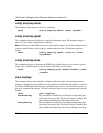
7000 Series L3 Managed Switch Reference Manual for Software v2.0
7-20 Switching Commands
config snmptrap delete
This command deletes trap receivers for a community.
Format config snmptrap delete <name> <ipaddr>
config snmptrap ipaddr
This command assigns an IP address to a specified community name. The maximum length of
name is 16 case-sensitive alphanumeric characters.
Note: IP addresses in the SNMP trap receiver table must be unique. If you make multiple entries
using the same IP address, the first entry is retained and processed. All duplicate entries are
ignored.
Format config snmptrap ipaddr <ipaddrold> <name>
<ipaddrnew>
config snmptrap mode
This command activates or deactivates an SNMP trap. Enabled trap receivers are active (able to
receive traps). Disabled trap receivers are inactive (not able to receive traps).
Format config snmptrap mode <enable|disable> <name>
<ipaddr>
show trapflags
This command displays trap conditions. Configure which traps the switch should generate by
enabling or disabling the trap condition. If a trap condition is enabled and the condition is detected,
the switch's SNMP agent sends the trap to all enabled trap receivers. The switch does not have to
be reset to implement the changes. Cold and warm start traps are always generated and cannot be
disabled.
Format show trapflags
Authentication Flag May be enabled or disabled by selecting the corresponding line
on the pull-down entry field. The factory default is enabled. Indi-
cates whether authentication failure traps will be sent.
Link Up/Down Flag May be enabled or disabled by selecting the corresponding line
on the pull-down entry field. The factory default is enabled. Indi-
cates whether link status traps will be sent. Multiple Users Flag.


















